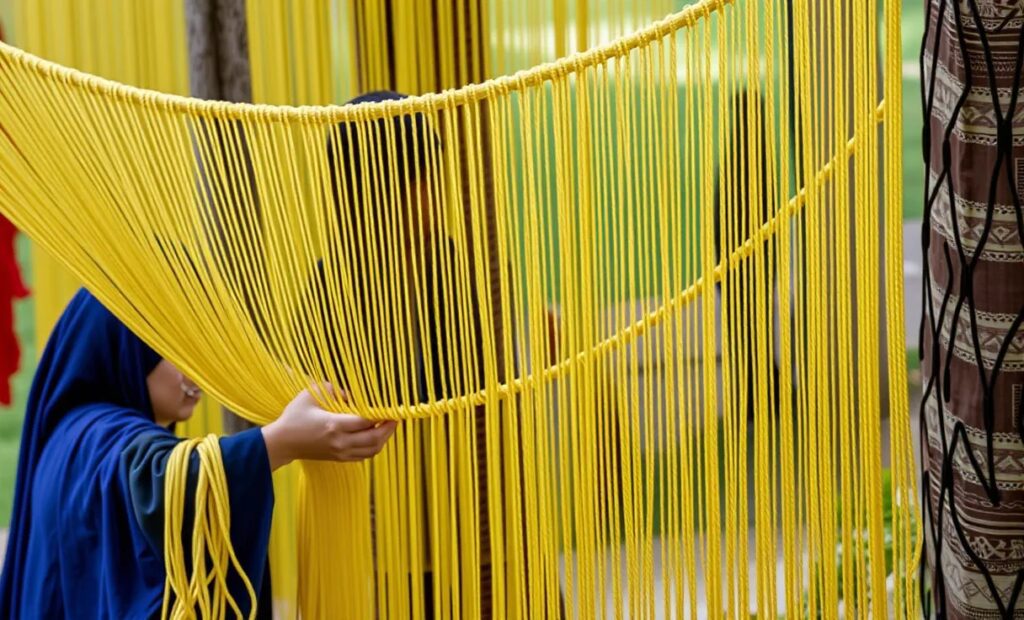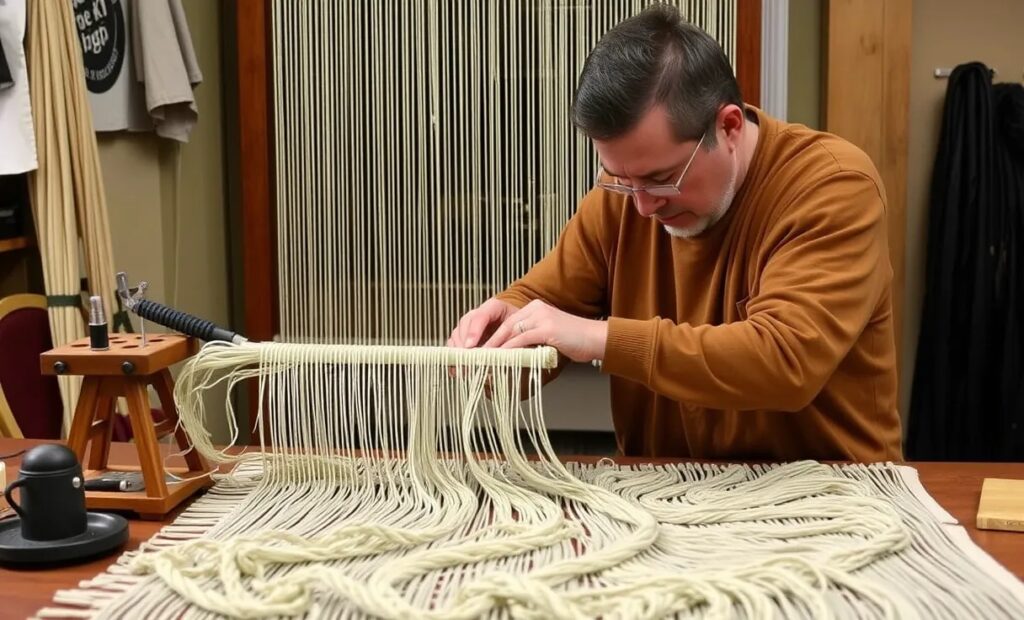
Unraveling the Mystery of Quipus
What Are Quipus?
Quipus, an ancient record-keeping tool used by the Inca civilization, are a fascinating blend of art and data. These intricate assemblies of knotted cords were used for a variety of purposes, including accounting, census data, and storytelling.
Instead of written language, the Incas relied on different knot types, positions, and cord colors to encode their information. Think of it as a physical spreadsheet, centuries ahead of its time.
Today, deciphering quipus is a challenge, but their potential to offer insights into ancient societies has sparked renewed interest.
The Complexity of Knotted Records
Each quipu consists of:
- A main cord acting as a “spine.”
- Hanging strings of varying lengths and colors.
- Complex patterns of knots indicating numeric or narrative data.
Despite their beauty, interpreting these records is no simple task. Much of the Inca’s knowledge about quipu use was lost after the Spanish conquest.
A Treasure Trove of Data
Researchers believe quipus hold critical clues about Inca civilization, from trade networks to administrative structures. They are a snapshot of a thriving, organized society that thrived without writing as we know it.
Unlocking these cords could revolutionize our understanding of pre-Columbian history.

How Modern Technology Is Transforming Quipu Research
The Role of Digitization
With advances in digital imaging and AI, scholars now aim to preserve and interpret quipus in ways previously unimaginable.
High-resolution scanning and 3D modeling allow researchers to capture:
- Knot structure in microscopic detail.
- Wear patterns revealing usage over time.
- Precise color data from fading threads.
These digital tools not only preserve the physical quipus but also make their analysis accessible to scholars worldwide.
AI Deciphering Ancient Codes
AI-powered software excels at recognizing patterns—perfect for analyzing quipus. By training algorithms on known quipu datasets, researchers are uncovering:
- Repetitive numeric patterns.
- Statistical anomalies pointing to unique messages.
- Connections between quipu designs and specific regions or eras.
Crowdsourcing Historical Research
Digitization enables crowdsourced efforts. Online platforms invite history enthusiasts to explore quipu datasets, contributing to collective insights.
This collaborative approach is bridging the gap between amateur historians and professional scholars.
Combining Archaeology and Technology

From Field to File
Modern archaeologists are employing portable scanning devices and imaging tools in excavation sites to document quipus immediately upon discovery.
This reduces the risk of physical degradation and ensures that every detail is preserved, even in remote conditions.
Interdisciplinary Collaboration
Historians, data scientists, and linguists are teaming up to analyze quipus from multiple perspectives. Such collaborations are uncovering hidden patterns in Inca administration and culture.
The fusion of traditional methods with cutting-edge technology highlights the power of interdisciplinary research.
Rediscovering the Cultural Significance of Quipus
A Window into Inca Society
Quipus were more than just data storage devices. They were tools of storytelling and cultural expression. Their complexity suggests a society deeply invested in systematic record-keeping and oral tradition.
By digitizing and studying these artifacts, researchers hope to:
- Decode ancient Inca narratives and myths.
- Understand the role quipus played in daily life and governance.
- Reconstruct trade routes and resource distribution.
Preserving a Lost Language
Some scholars speculate that quipus could represent a lost language or script. The relationship between knot patterns and spoken Quechua—a dominant language of the Inca Empire—is a tantalizing area of study.
If this connection proves true, quipus could redefine how we perceive non-written communication systems in human history.
Celebrating Indigenous Knowledge
For modern Quechua-speaking communities, quipus represent a direct link to their heritage. By engaging these communities in the research, digitization efforts also act as a form of cultural reclamation, spotlighting indigenous knowledge systems.
Challenges in Deciphering and Digitizing Quipus

Gaps in Historical Context
One major hurdle in quipu research is the lack of contextual knowledge. Without a Rosetta Stone equivalent, decoding their full meaning involves significant speculation.
Researchers rely on:
- Comparing quipus to surviving Spanish accounts.
- Aligning quipu patterns with known Inca practices.
- Leveraging AI to test potential interpretations.
Physical Deterioration
Many quipus have suffered from centuries of neglect. Fragile fibers and faded colors complicate digitization, making preservation techniques critical.
Ethical Considerations
Quipus are cultural treasures. As digitization projects move forward, researchers must ensure that indigenous perspectives are respected and that data remains accessible to originating communities.
A Glimpse into the Future
Unlocking Untold Stories
The digital revolution in quipu research could lead to breakthroughs that fundamentally change our understanding of the ancient Americas. Every knot, twist, and cord might hold untold stories about the Inca Empire’s rise, administration, and fall.
Inspiring New Technologies
Quipus are also inspiring modern innovations. Their design principles—simple yet scalable—offer ideas for sustainable data storage in the digital age.
The journey to fully understand quipus continues, and with modern technology leading the way, the past and present are coming together in unexpected ways.
Quipus in a Global Context: Why Their Discovery Matters
Redefining Historical Records
Quipus challenge the traditional definition of written records. While civilizations like Egypt or Mesopotamia relied on texts and inscriptions, the Incas devised a system uniquely suited to their environment.
By broadening the scope of what qualifies as a record, scholars are reevaluating other non-textual systems worldwide, such as:
- Polynesian stick charts for navigation.
- African talking drums for communication.
- European tally sticks for accounting.
Quipus exemplify the diverse ways humans encode and share information.
Lessons for the Digital Age
The concept of using compact, durable systems like quipus is remarkably relevant today. As digital systems grow more complex, quipus serve as an inspiration for minimalist, sustainable data solutions.
Some researchers believe quipus could inform innovations in:
- Compact data encoding.
- Disaster-proof record storage.
- Decentralized systems for resource management.
Connecting the Ancient and Modern World
Quipus are not merely artifacts of a bygone era. They act as a bridge between past ingenuity and future potential, showcasing how ancient knowledge can inform modern challenges.

The Role of Public Engagement in Quipu Research
Making Quipu Data Accessible
Digitization ensures that quipus are not confined to museums. Online platforms now host interactive quipu datasets, allowing anyone to explore their mysteries.
Educational initiatives, such as virtual reconstructions, are bringing these artifacts into classrooms and engaging younger generations in historical research.
Indigenous Partnerships
Partnering with indigenous communities is key to understanding quipus holistically. Quechua-speaking elders, for instance, may hold valuable oral traditions that align with quipu interpretations.
These collaborations foster not only academic insights but also cultural revitalization.
A Growing Global Interest
Interest in quipus is expanding beyond academic circles. From documentaries to art installations, quipus are inspiring creative projects worldwide, sparking curiosity about the Inca civilization.
Beyond Quipus: What This Means for History
A Broader Perspective on Human Innovation
The study of quipus is shifting our perception of ancient societies. It reminds us that intelligence and creativity are universal traits, taking many forms across time and space.
The focus on quipus encourages researchers to approach other underexplored artifacts with fresh eyes, unearthing hidden stories of human resilience and adaptation.
Charting a New Course for Archaeology
The integration of AI and digitization tools in quipu research signals a larger shift in archaeology. These technologies are enabling:
- Faster, more accurate artifact analysis.
- New methodologies for exploring non-textual records.
- Greater collaboration across disciplines and borders.
This marks the beginning of a new era in historical studies, where technology and tradition coalesce to reveal humanity’s rich, interconnected past.
Conclusion: Tying Together Ancient Wisdom and Modern Insights
The digitization of quipu data is more than just a technological marvel—it’s a profound journey into the heart of Inca innovation. With each knot decoded, we not only illuminate a lost civilization but also find parallels that resonate with our own.
By blending modern tools with ancient wisdom, quipus remind us that history isn’t just behind us—it’s in the making.
FAQs
How do researchers digitize quipus?
Digitization involves capturing high-resolution images and 3D models of each quipu. Advanced techniques, like infrared imaging, reveal details like faded dye patterns. For example, one project used AI to compare quipu designs, linking similar patterns to specific Inca regions.
Are there modern applications inspired by quipus?
Yes, quipus inspire innovations in compact data storage and visualization. For example, researchers are studying quipu designs to develop minimalist coding systems for use in technology. Their efficient, knot-based approach to storing vast amounts of data is highly relevant in today’s tech-driven world.
Can anyone access digitized quipu data?
Yes, many museums and research institutions offer online archives of digitized quipus. For example, Harvard University’s Khipu Database Project provides open access to quipu records, allowing scholars and enthusiasts to explore these artifacts from anywhere in the world.
Do quipus still hold cultural significance today?
Absolutely. For modern Quechua-speaking communities, quipus symbolize cultural resilience and identity. Some indigenous artists and educators are even reviving quipu-making techniques to preserve and celebrate this heritage. For example, workshops teach children to create their own quipus while learning about Inca history.
Are there other civilizations with similar systems?
Yes, other societies have used non-textual recording systems. For example:
- Polynesians used stick charts to map ocean currents.
- African communities utilized drum codes for communication.
- Medieval Europeans employed tally sticks for bookkeeping.
These parallels highlight the universal human drive to document and communicate.
How are the colors in quipus significant?
Colors in quipus held symbolic and practical significance, often representing categories of data or elements of nature. For instance, green cords might signify crops, while yellow could indicate gold or corn. In some cases, color combinations added layers of meaning, much like a modern infographic.
How many quipus have been discovered so far?
To date, approximately 600 quipus have been found. Most were unearthed in Peru and nearby regions. For example, a large cache of quipus discovered in the ruins of Pachacamac near Lima revealed details about Inca religious practices and temple administration.
Why did the Spanish suppress quipus?
The Spanish colonial authorities viewed quipus as threats to their control, associating them with indigenous knowledge and resistance. In their efforts to eradicate non-Christian practices, many quipus were destroyed. This historical loss makes every surviving quipu even more valuable to researchers today.
How do quipus differ from written records?
Unlike written records that rely on symbols and alphabets, quipus use a tactile system of knots, lengths, and colors. They’re more akin to spatial memory tools than linear text. For example, a single quipu could simultaneously encode tax data, census numbers, and calendar information, organized in a multidimensional way.
Can quipus help us understand pre-Columbian trade networks?
Absolutely. Some quipus are believed to have functioned as trade ledgers, recording goods exchanged between regions. For example, a quipu from the coastal Andes might include data about fish traded for potatoes from the highlands. By analyzing these records, researchers reconstruct economic relationships within the Inca Empire.
Are there modern efforts to recreate quipus?
Yes, contemporary scholars and artisans are working to revive the art of quipu-making. For instance, experimental archaeologists create replicas to test theories about knot construction and usage. Similarly, some schools in Peru integrate quipu-making into their curricula to reconnect students with their ancestral heritage.
How can I learn more about quipus?
Many resources are available for enthusiasts, including:
- The Khipu Database Project, which offers a comprehensive catalog of quipus.
- Books like “Reading the Knots: Decoding Inca Quipus” by Sabine Hyland.
- Documentaries such as “The Knotted Code,” which explore quipu discoveries and research.
These tools offer deep insights into the fascinating world of quipus!
Resources
Online Databases
- Khipu Database Project: A comprehensive resource hosted by Harvard University that catalogs digitized quipus. You can explore high-resolution images, metadata, and interpretations. Visit: Khipu Database Project.
- Digital Archive of Andean Textiles and Quipus: Focused on the visual and structural details of quipus, this platform showcases how quipus integrate with textile traditions.
Books
- “Reading the Knots: Decoding Inca Quipus” by Sabine Hyland
A detailed exploration of quipu analysis and the stories behind their discovery. Hyland offers a mix of history, anthropology, and cutting-edge research. - “The Ancient Civilizations of Peru” by J. Alden Mason
While broader in scope, this book offers a thorough introduction to Inca culture, including their use of quipus. - “Stringing the Past: The Khipu and Andean Information Systems” by Jeffrey Quilter and Gary Urton
A great choice for understanding the historical and mathematical complexity of quipus.
Documentaries & Videos
- The Knotted Code: A documentary available on streaming platforms that delves into the history of quipus and modern digitization efforts.
- TED Talk by Sabine Hyland: Offers an accessible introduction to the science and mystery behind quipus. Search “Sabine Hyland quipus TED” on YouTube.
Museums and Institutions
- Museo Larco (Lima, Peru): This museum holds some of the most well-preserved quipus and contextualizes them within Inca society.
- British Museum (London): Features quipus in its collection of pre-Columbian artifacts.
- Smithsonian National Museum of the American Indian (USA): Occasionally showcases quipus in exhibitions related to Andean cultures.
Online Articles
- National Geographic: “Unraveling the Mysteries of the Inca’s Knotted Strings”
A reader-friendly overview of quipu history and digitization efforts.
Read Here. - Scientific American: “Decoding the Inca Quipus with AI”
This article examines how artificial intelligence is transforming our understanding of quipus.
Research Papers
- “Mathematical Implications of the Inca Quipus” by Gary Urton
Published in peer-reviewed journals, this paper explores the numeric patterns found in quipus. - “Quipu and the Andean Worldview”
This interdisciplinary study links quipu structure to broader aspects of Inca culture.
Educational Workshops and Communities
- Quipu Workshops in Cusco, Peru: Local organizations offer hands-on learning experiences about quipu creation and decoding.
- Andean Anthropology Forums: Online communities where enthusiasts and researchers discuss quipu findings and theories.
Thank for the info RoX818, I’m an undergraduate student at uncw working on integrating AI and deep learning for a future graduate project.
With pleasure louis! I’m glad it was helpful to you!